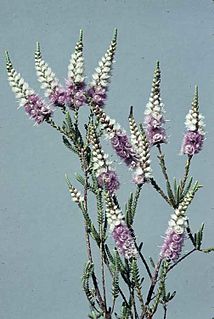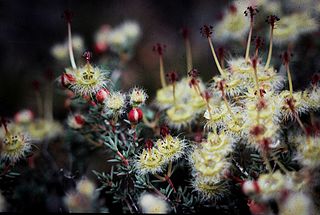
Eremophila youngii is a flowering plant in the figwort family, Scrophulariaceae and is endemic to Western Australia. It is a dense, erect shrub with many of its parts covered with a layer of grey to yellowish-grey scales and with pink, purple or red flowers.
Verticordia forrestii, commonly known as Forrest's featherflower, is a flowering plant in the myrtle family, Myrtaceae and is endemic to the north-west of Western Australia. It is a shrub with small, egg-shaped leaves and massed displays of scented pink to red flowers in spring.
Verticordia capillaris is a flowering plant in the myrtle family, Myrtaceae and is endemic to the south-west of Western Australia. It is a shrub with a single stem at the base, small leaves and creamy white or occasionally pink flowers in dense corymb-like groups. It is common in small areas near Geraldton.
Verticordia crebra, commonly known as Barrens featherflower, crowded featherflower or Twertup featherflower, is a flowering plant in the myrtle family, Myrtaceae and is endemic to the south-west of Western Australia. It is a sprawling shrub with crowded, cylinder-shaped leaves with small, yellow flowers that are almost hidden by the leaves but with a style which extends well beyond the petals. The plant looks superficially like a miniature pine tree.

Verticordia halophila, commonly known as salt-loving featherflower, or salt-loving verticordia, is a flowering plant in the myrtle family, Myrtaceae and is endemic to the south-west of Western Australia. It is an erect, bushy shrub with small, crowded, thick leaves and spikes of red and pink flowers in spring.

Verticordia helichrysantha, commonly known as coast featherflower or Barrens featherflower, is a flowering plant in the myrtle family, Myrtaceae and is endemic to the south-west of Western Australia. It is a small, woody, open-branched shrub with crowded, linear leaves and small yellow flowers from May to September.
Verticordia verticordina is a flowering plant in the myrtle family, Myrtaceae and is endemic to a small area near the coast of the south-west of Western Australia. It is a small, low-growing shrub with crowded leaves and in spring, scattered pale greenish-cream and golden brown flowers. Its unusual flowers and fleshy leaves give the plant a superficial resemblance to a Darwinia.

Verticordia spicata, commonly known as spiked featherflower, is a flowering plant in the myrtle family, Myrtaceae and is endemic to the south-west of Western Australia. It is usually a dense, bushy shrub with small leaves pressed against the stem and spikes of pink flowers from late spring to early summer.
Verticordia helmsii is a flowering plant in the myrtle family, Myrtaceae and is endemic to the south-west of Western Australia. It is a shrub with most of its leaves clustered on short side branches and with small groups of scented creamish-white flowers in small groups along the branches.
Verticordia hughanii, commonly known as Hughan's featherflower, is a flowering plant in the myrtle family, Myrtaceae and is endemic to the south-west of Western Australia. It is a small shrub with spreading, oblong leaves and spike-like groups of bright red flowers near the ends of the branches. It is a rare plant, only known from three small populations and currently meets the requirements of the World Conservation Union Red List Category "Endangered".
Verticordia interioris is a flowering plant in the myrtle family, Myrtaceae and is endemic to the south-west of Western Australia. It is an openly branched shrub with small, linear leaves and rounded groups of pale to dark pink flowers in early spring.
Verticordia lepidophylla is a flowering plant in the myrtle family, Myrtaceae and is endemic to the south-west of Western Australia. It is usually a bushy shrub with small leaves and spikes of creamish-green to yellow flowers in spikes along the branches in late spring to early summer.
Verticordia luteola is a flowering plant in the myrtle family Myrtaceae, and is endemic to the south-west of Western Australia. It is a more or less openly branched shrub with crowded leaves on its side branches and spikes of pale yellow or bright pink flowers which turn cream to brownish as they age. This verticordia is a summer-flowering species.
Verticordia minutiflora is a flowering plant in the myrtle family, Myrtaceae and is endemic to the south-west of Western Australia. It is a bushy shrub with small, crowded, cylindrical leaves and groups of white to pale pink flowers in summer and autumn. As suggested by its botanical name, it has the smallest flowers of any verticordia.
Verticordia mirabilis is a flowering plant in the myrtle family, Myrtaceae and is endemic to a small area in the Gibson Desert. It is a bushy, spreading shrub with its leaves mostly crowded on short side branches and with large, deep red flowers in small groups in spring.

Verticordia penicillaris is a flowering plant in the myrtle family, Myrtaceae and is endemic to the south-west of Western Australia. It is a small, widely spreading shrub, usually with several main branches. It is readily distinguished from other verticordias by its yellow flowers with white fringes and purple hairs on the end of their long styles.
Verticordia pholidophylla is a flowering plant in the myrtle family, Myrtaceae and is endemic to the south-west of Western Australia. It is a shrub with a single branch at the base and many side branches with overlapping yellowish leaves and greenish-white to cream, cup-shaped, feathery flowers.
Verticordia pityrhops, commonly known as East Mount Barren featherflower or pine-like featherflower, is a flowering plant in the myrtle family, Myrtaceae and is endemic to the south-west of Western Australia. It is a single-stemmed shrub which is densely-branched with crowded narrow linear leaves giving the impression of a miniature pine tree. When it flowers in autumn, the shrub is completely covered with masses of very small, honey-scented, pinkish-purple flowers.
Verticordia polytricha, commonly known as northern cauliflower, is a flowering plant in the myrtle family, Myrtaceae and is endemic to the south-west of Western Australia. It is an erect, bushy shrub with linear leaves and dense heads of white flowers in late spring and summer.
Verticordia rennieana is a flowering plant in the myrtle family, Myrtaceae and is endemic to the south-west of Western Australia. It is an openly branched shrub with small, narrow, warty leaves and pink and silvery-white flowers in spring and summer.





